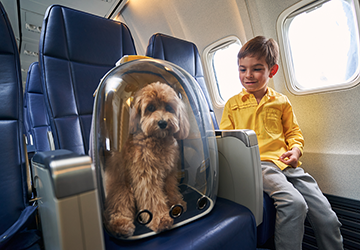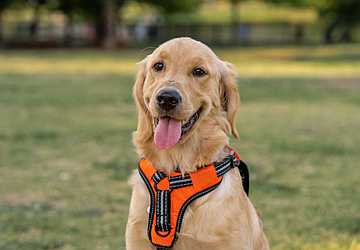Traveling with Pets: A Stress-Free Journey
Adventures are always more fulfilling when shared, and who better to accompany you than your loyal pet? Whether it's a weekend getaway or a cross-country journey, ensuring your pet's comfort is vital. With the increasing acceptance of furry companions in various establishments, choosing pet-friendly travel destinations has become easier than ever. Yet, the actual transit process, especially if it involves airplane travel with pets, can be daunting. From understanding the packing essentials for pet travel to strategies for keeping pets calm during transit, this guide offers insights to ensure you and your pet have an enjoyable travel experience.
Pet-Friendly Travel Destinations
In recent years, the rise of pet-friendly travel destinations has been significant. Hotels, resorts, and even some beaches are now more accommodating to our four-legged companions. However, it's essential to research and confirm your chosen destination's " pet-friendliness " level. While some places only allow smaller pets, others might provide exceptional amenities like pet spas, play areas, and gourmet pet menus. Always check the rules and restrictions of the destination and any potential fees or deposits required for pets.

Tips for Aeroplane Travel with Pets
Airplane travel with pets is the most complicated segment of pet travel. Before you book, investigate the airline's pet policy. Small pets can fly in the cabin with some airlines, while larger animals may need to go in the cargo hold. Don't forget to:
● Visit your veterinarian: Ensure your pet has up-to-date immunizations and is healthy enough to fly.
● Choose a direct flight when possible to minimize stress for your pet.
● Invest in a sturdy, well-ventilated, and airline-approved carrier. Label it with your contact information.
● Familiarise your pet with the carrier days before the journey.
Packing Essentials for Pet Travel
Packing essentials for pet travel involves more than just their food and toys. Think of it as packing for a toddler. Here's a handy checklist:
● A comfortable carrier or crate with a soft bed or blanket.
● Food and water for the journey, along with bowls. Remember to carry extra portions in case of delays.
● A leash, harness, or both.
● Familiar items like toys, blankets, or clothing with your scent.
● Any medications your pet might need.
● A pet first-aid kit.
● Waste bags or litter for cats.
● A recent pet photo in case they get misplaced.
Keeping Pets Calm During Transit
The unfamiliarity of transit can be anxiety-inducing for pets. Keeping pets calm during transit is crucial for their well-being. Consider these tips:
● Stick to routines: Maintain your pet's regular feeding, play, and sleep schedules.
● Comfort items: As mentioned earlier, familiar toys or a piece of your clothing can offer solace.
● Calming aids: Consult your vet about safe calming supplements or sprays.
● Stop for breaks: If traveling by car, frequent stops can help pets stretch and relieve themselves.
● Reassurance: Talk to them in a calm, soothing voice. Physical comfort, like petting, can also help.
Understanding Pet Passports and Quarantine Rules
One of the more technical facets of traveling with pets is understanding the need for pet passports and the quarantine rules of your destination. A pet passport contains all your pet's medical records and ensures they are free from rabies and other diseases. Many countries have stringent regulations to prevent the introduction of foreign diseases. Before traveling, familiarise yourself with the requirements of your destination country and start preparing months in advance.
Pet-Friendly Activities
Once you've chosen among the myriad pet-friendly travel destinations, it's not just about where you'll stay but also what you'll do. Many cities now offer pet-friendly cafes, parks, and even shopping centers. Researching in advance can give you a list of activities to enjoy with your pet. From dog-friendly beaches to cat cafes, a world of exploration awaits you and your furry friend.
Handling Emergencies
No one likes to think about it, but emergencies can happen. Before you embark on your journey, especially if it involves airplane travel with pets, it's imperative to know the location of the nearest veterinarian or animal hospital to your accommodation. Having a list of emergency contacts and ensuring you have an accessible pet first-aid kit, as mentioned in the packing essentials for pet travel, can make all the difference in stressful situations.

Cultural Differences and Local Etiquette
Depending on your travel destination, the local populace may have differing views and etiquette concerning pets. In some places, it might be common to see pets in restaurants and shops, while in others, it could be frowned upon. Familiarising yourself with local customs and pet etiquette can prevent awkward situations and ensure a harmonious experience during your stay.
Travel Insurance for Pets
As we get travel insurance, considering pet insurance is a wise choice. Such insurance can cover unexpected veterinary costs, loss, or even theft. Knowing that you're financially protected against unforeseen incidents provides peace of mind.
Choosing the Right Accommodation
When zeroing in on pet-friendly travel destinations, accommodation is paramount. Not all "pet-friendly" hotels are created equal. While some might merely tolerate pets, others celebrate them. When booking, inquire about the specifics:
● Room Location: Some establishments might offer rooms on the ground floor for easy outdoor access, while others could allocate specific zones for pet owners.
● Pet Amenities: High-end hotels might offer gourmet pet menus, pet spas, and pet-sitting services.
● Restrictions: Always check if there are size or breed restrictions. Some hotels might only allow small dogs, while others might welcome all with open arms.
Pet Safety During Travel
If airplane travels with pets isn't on the agenda, and you're hitting the road instead, pet safety in the vehicle is essential:
● Use a robust carrier, allowing your pet to stand up, turn around, and lie comfortably.
● You can purchase specialized pet seat belts to keep your pet safe in an accident or sudden braking.
● Never Leave Pets Alone: Especially in cars. Temperatures can rise rapidly in parked vehicles, leading to heatstroke or worse.




